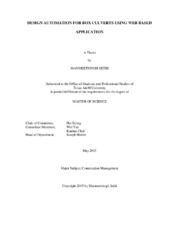| dc.description.abstract | One of the fast and economical ways of putting tunnels or stream crossings under roadways is to use box culverts. Box culverts are structurally rigid, easy to construct, and easy to add length when needed. Because of their simple geometric configuration, precast concrete box culverts with various dimensions are commonly used in the U.S. In some cases, non-standard box culverts are also used, for which the design document has to be produced per project design specification. The design process of box culverts is relatively easy and repetitive because of their typical geometric configuration. In practice, engineers are following exactly the same process with different dimensions and loading conditions to design box culverts. Microsoft Excel spreadsheet is therefore often used to speed up this repetitive calculation process.
In India, many designers use STAAD.Pro for the structural analysis of box culverts and bring the results of this analysis to a Microsoft Excel spreadsheet to carry out the remaining calculations. However, all these cases are dealt separately and a significant amount of time is used to come up with the final design. In addition, it has been challenging to keep all engineering calculations and drawings of a specific box culvert for its lifecycle. One of the solutions that one can come up with for this challenge is to automate the entire design process in one package and keep all design documents in one location.
This study presents the Web-based application we developed to 1) automate the box culvert design process and 2) keep all design documents in one location. This Web-based application is developed based on Indian Standard codes (IS) and Indian road congress codes (IRC) using ASP.net. This study presents how this application was developed, how it is working, and how it improved the design process of box culverts in our tests. This study shows that results obtained from this application are very close to the traditional design process and can be successfully used for designing of box culverts in India. Also the study concludes that there is a significant amount of time saving in the design process when this application is used instead of traditional design process. | en |


